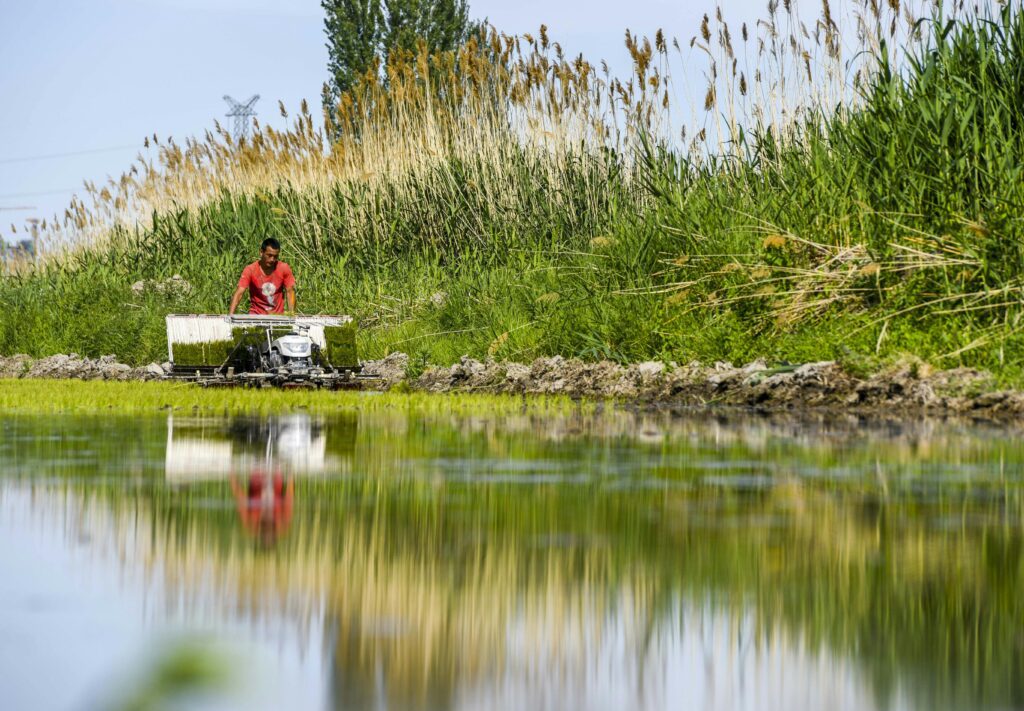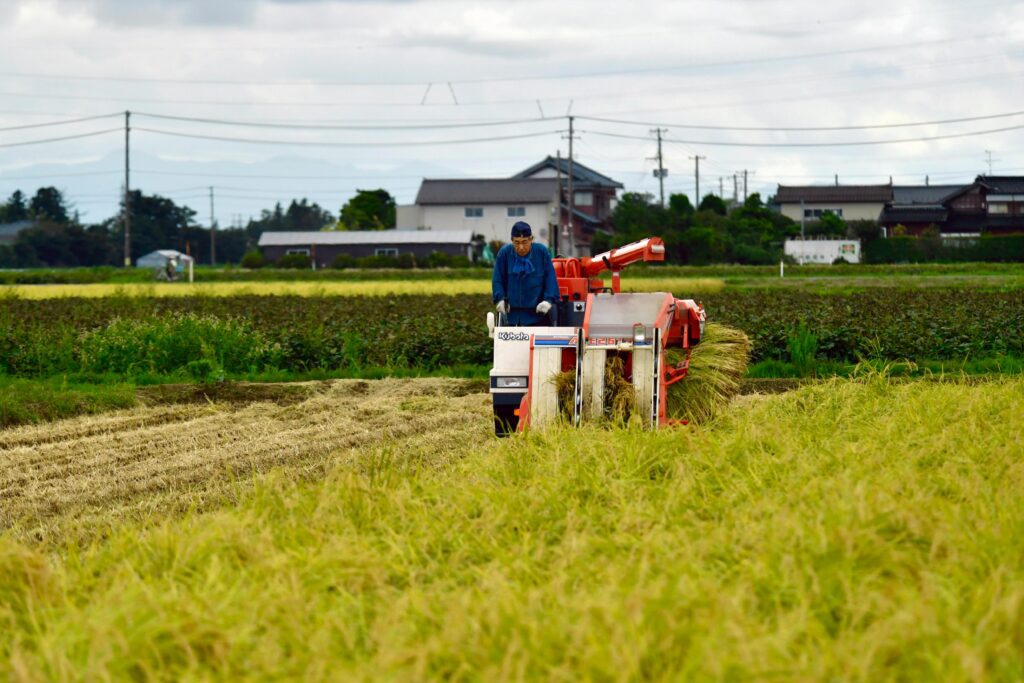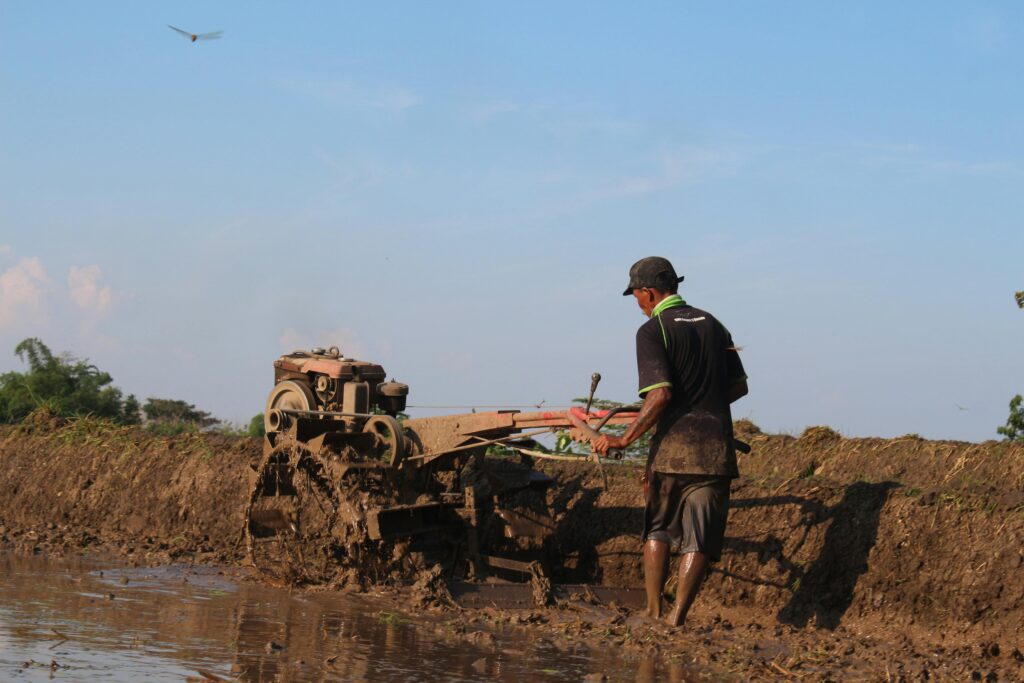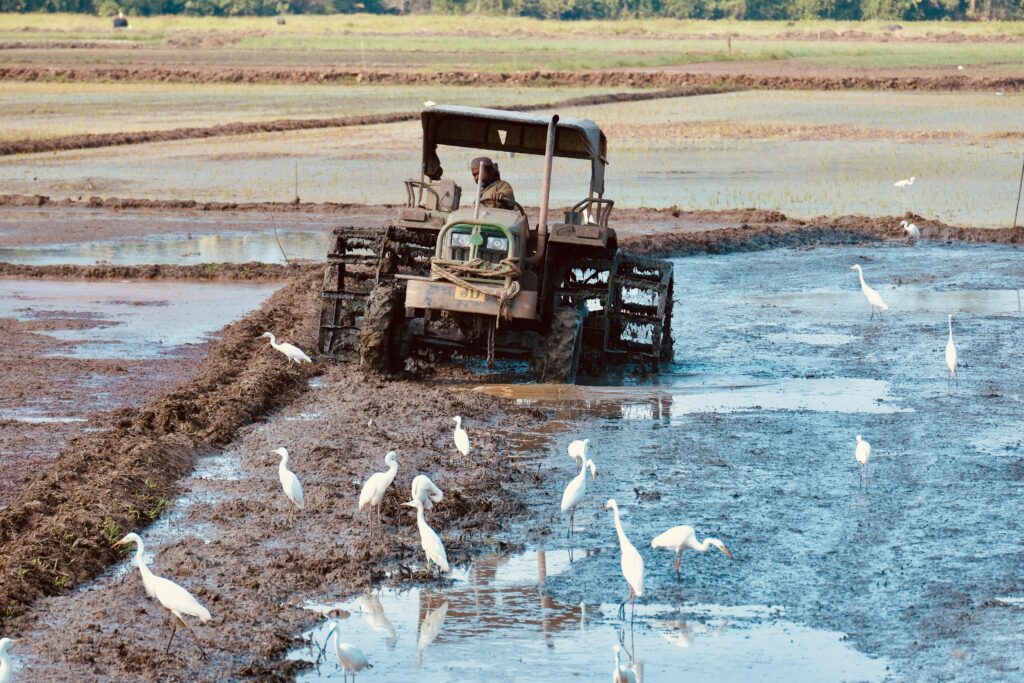Table of Contents
Introduction
The Face of Revolution in Indian and Global Farming
Farmers are witnessing a revolutionary shift in farming, where new tools have replaced centuries-old traditional methods. Among the numerous tools that are transforming farming today, the happy seeder has been a revolutionary tool.
This machine, apart from saving time and labor, also solves significant environmental problems like burning crop residue. Since it seeds wheat seeds into the soil without uprooting residual rice straw, it enables farmers to improve soil quality, save money, and gain more yield.
Apart from the happy seeder, other recent farm machinery such as the super seeder and rice planter machine are also enhancing farming efficiency through the application of precision technology for daily farming. All these machines are the epitome of the future of green and profitable farming practice.
Why the Happy Seeder is a Farmer’s Best Friend
The use of the happy seeder has risen dramatically in the last few years, particularly in the rice-wheat belts of production. Farmers who previously found it hard to manage stubble were freed from the risky art of burning crop waste.
With higher soil fertility, purer air, and better yield, the happy seeder has now emerged as the farmer’s closest companion.

Coupled with the versatility of the super seeder and the efficiency of the rice planter machine, the happy seeder is part of an invincible trio that fortifies food security while ensuring agriculture is environmentally friendly.
In this blog, we’ll explore 7 proven secrets that highlight how these machines can unlock immense agricultural potential.
Benefits of Using the Happy Seeder, Super Seeder & Rice Planter Machine
Improved Soil Health and Fertility
One of the most important benefits of the use of the happy seeder is the improved quality of soil. Farmers once used to burn crop residue to rapidly clear fields, but the process ruined organic matter, lowered the fertility of the land, and posed tremendous environmental threats.
In contrast, with the happy seeder, crop stubble is left on the surface as mulch that naturally decomposes and adds organic carbon to the soil. The process enhances soil texture, water storage, and microbial life—all vital for healthy plant growth.
Likewise, the super seeder is also performed by direct in-situ inclusion of crop residue in the soil during sowing of the seed, and a natural cover is formed that avoids erosion and loss of moisture by evaporation.
In contrast, the rice planter machine provides even planting depth, which enables seedlings to grow sturdy and nourish well. Combined, these machines not only minimize the use of chemical fertilizers but also enhance sustainable agriculture by reinforcing the cycle of natural soil fertility.
Time-Saving and Efficient Land Preparation
Farmers are usually under pressure during the period between wheat harvesting and rice transplanting, where they have only weeks to prepare fields. Happy seeder addresses this by enabling farmers to sow wheat seeds directly into rice stubble fields.
This obviates the necessity of undertaking multiple tillage operations and conserves precious time. In states such as Punjab and Haryana, where changeover from one crop to another is very brief, the jubilant seeder has proved to be a lifesaver of machinery in ensuring production without causing any damage to the environment.
The super seeder also allows for two operations simultaneously—mixing the residue with soil while planting seeds—providing double advantage to farmers. The rice transplanting machine makes this efficiency possible by minimizing labor in paddy transplantation, conserving time and energy.
The small- and large-scale farmers are helped by these machines to get the fields ready on time, resulting in enhanced crop cycles and timely harvesting.
Decrease in Air Pollution and Environmental Impact
One of the better-known advantages of the happy seeder is its ability to minimize stubble burning, a process guilty of generating lethal air pollution throughout northern India. Rice residues worth millions of tons get burned every winter, causing smog and public health risks for both town and rural dwellers.
By making burning impossible, the seedy seeder enables farmers to help create cleaner air and a healthier community. The super seeder takes it a notch higher by planting the residue under the ground, turning trash into gold.
In the same vein, the rice planter machine lessens the quantity of manual transplantation that wastes enormous amounts of water, conserving natural resources.

All these technologies put together accomplish the global agenda of climate-smart agriculture by reducing the emissions of greenhouse gases, avoiding soil erosion, and encouraging ecologically sustainable agriculture.
Farmers who utilize these machines not only become economically benefited but are also uniting under sustainable development.
Lowered Cost and Increased Profitability
Control over costs for farmers is as important as productivity. The contented seeder saves growers a great amount of money by eliding several field operations, reducing fuel, labor, and fertilizer costs. Growers will not need to shell out for residue removal or extra labor anymore.
Growers can ready the ground in a single operation. The super seeder achieves the same cost savings by doing two operations in one machine—residue management and planting. This efficiency reduces the requirement for costly machinery or the employment of tractors in multiple passes.
The rice planter machine also economizes on labor by mechanizing transplanting, traditionally a time and labor-intensive process. Mechanization becomes financially viable with increased wages and labor scarcity. With time, cost savings from lower inputs and better yields lead to increased profitability.
Some farmers have reported that upon using these machines, their return on investment was far better, enhancing the economic viability and stability of agriculture.
Methods to Maximize the Happy Seeder, Super Seeder & Rice Planter Machine Power
Proper Field Preparation with the Happy Seeder
While the happy seeder has been specifically created for use in rice stubble fields, proper field preparation truly comes into play. Farmers may start by making sure that when they harvest the rice crop, there remains an even straw cover on the ground.
Implementation of a straw management system (SMS) on combine harvesters guarantees even dispersion of stubbles in a way that the happy seeder works more effectively.
For tilling using the happy seeder, farmers have to adjust the machine to a best seed planting depth for wheat seeds, typically between 4 and 6 centimeters, based on the type of soil.
Tractor speed should also be regulated—working too fast will lead to inefficient seed placement, while being too slow will lower efficiency. Farmers are also advised to inspect the seed metering system from time to time for uniformity of distribution.
With correct technique, the jubilant seeder saves time while ensuring proper germination for increased production at no environmental expense of burning residues.
Double Function of the Super Seeder
The super seeder merges the two critical functions—handling residue and planting seed—into a single function. For maximal efficiency, farmers will have to focus on equipment calibration and the use of residues.
The super seeder blades chop and blend stubble into the soil, forming a natural mulch that retains moisture. Seeds, however, are directly planted into soil to facilitate rapid germination. The secret method used is the variation of blade depth and seed sowing in certain soils.
For sandy soil, seeds need to be sown deeper to access moisture, while for clay soil, shallowness of planting is best. The farmers should also monitor residue so as not to clog and provide uninterrupted passage.

Through the acquisition of these modifications, the super seeder saves time and effort, rendering it one of the most convenient tools for modern agriculture. Accurate application has the potential to convert the erstwhile crop residues into a useful conditioner for soil.
Precision Planting through the Rice Planter Machine
The rice planter machine is a very efficient method of transplanting paddy seedlings in a coordinated way throughout the field. The performance of this machine is highly dependent on nursery preparation of rice seedlings.
Farmers have to raise seedlings in trays or mats that are suitable with the planter, having solid root systems and balanced development. During the operation of the rice planter machine, the right water levels within the field are of maximum significance.
Fields would ideally be covered with a shallow cover of water, enough to hydrate the seedlings but not drown them. The machine subsequently plants seedlings on the same level and spacing to allow the plants to gain access to the nutrients better.
The routine care of the planting fingers is also another significant technique that allows the process to go on without damaging seedlings. All these techniques help save labor costs and time for farmers, as well as improved yields through repeated establishment of crops.
Rice planter machinery is particularly worth its weight in gold during times of scarcity of labor and high pay.
Utilizing All Three Machines to Gain Maximum Profit
Though the super seeder, happy seeder, and rice planter machine are capable of doing extremely well on their own, the actual potential is realized when all three are operated together. The farmer can use the rice planter machine during the paddy season to ensure periodic planting with minimal man labor.
At the time of harvesting, rather than burning the stubble, the super seeder can be employed to include residue into the soil at the time of sowing the next crop.
It is also possible to directly plant wheat via the happy seeder without stripping the leftover straw. It is time- and cost-saving, in addition to enhancing soil health, minimizing pollution, and raising productivity season after season.
Combining these machines with agricultural practices is an integrated system in which one complements another. The outcome is a sustainable, eco-friendly, and profitable method of farming that solves the issues of current farming and provides long-term advantages to farmers and the environment as well.
Problems in Implementing the Happy Seeder, Super Seeder & Rice Planter Machine
Extremely High Initial Investment Expenses
One of the key issues with which farmers are confronted while implementing the use of the happy seeder is the price of buying the machine, which is very expensive at first.
In marginal and small farms, buying such extremely technologically sophisticated equipment seems too costly even though there are huge cost savings in the long run. The same goes for the super seeder and rice planter machine, which are all very expensive compared to ordinary tools.
Though in the long term these machines end up saving the farmer money through labor, fuel, and residue management costs, the initial investment price deters farmers from making the change.
When farm incomes in an area are already under stress, it is out of the question to purchase new equipment unsubsidized. It is through this reason that subsidies and government incentives take on the role of necessary stimuli to adopt.
Without knowledge of long-term returns, most farmers tend to follow conventional methods, unaware of the importance of mechanization and sustainable agriculture.
Lack of Awareness and Training
Even if equipment such as the happy seeder is available, lack of awareness and training will limit their fullest utilization. Most of the farmers lack understanding of how to calibrate seed depth, modify tractor speed, or service equipment for long-term operability.
For the super seeder, improper blade adjustments can lead to inadequate disposal of residue and uneven seed distribution. Rice planter machine operation also demands technical knowledge in nursery preparation, water level, and management of machines.
Unless trained, the farmer may become annoyed and think that the machine is inefficient while the actual problem is skill gaps. Moreover, where rural agricultural extension services are limited, the technology transfer is sluggish.

This is an issue where farmer workshops, field demonstration, and hands-on training programs need to be implemented so that farmers will have the confidence to use machines of this sort effectively.
Maintenance and Operating Challenges
Maintenance is also a problem with equipment such as the happy seeder and super seeder. The machines are efficient but need constant maintenance to continue functioning. Blades, seed measuring devices, and bearings usually need prompt replacement or maintenance.
For the rice planter machine, planting finger maintenance and lubrication are necessary to prevent breaks in operation. Farmers from rural areas also do not have access to spare parts or competent mechanics, thus slowing down the farm cycle.
Maintenance also results in low machine efficiency and decreasing lifespan. Inability to have smooth operations like clogging by stubble, irregular spread of residue, or compaction of ground will also discourage farmers seeking quick solutions.
Lacking both service networks and support facilities at the grassroots level, the majority of farmers are not willing to adopt these machines at all. Post-sale maintenance and readily accessible spare parts are important in breaking down such operational barriers.
Resistance to Change and Traditional Practices
Farm practices are deeply entrenched in rural society, and new practices are usually resisted. Most farmers oppose the happy seeder since they are used to old-fashioned plowing and residue burning.
They might consider mechanization as unnecessary or very cumbersome, particularly when the short-term result is not apparent. However, the super seeder and rice planter machine can seem daunting compared to manual labor or traditional equipment.
Behavior transcends generations as well—older farmers can prevent their younger counterparts from trying out new machines, fearing harm to their crops. This attitude restrains utilization of machines that would actually improve productivity and sustainability.
Long-term education, showcasing tangible success stories, and winning people’s confidence in the society help mitigate such resistance. When farmers can see neighbors making profits out of such machines, they are ready to adopt the change.
Changing from conventional approaches to new ones is a gradual and time-consuming process, though.
Solutions to Overcome the Challenges in Using Happy Seeder, Super Seeder & Rice Planter Machine
Financial Assistance and Government Subsidies
The expensive nature of machines like the happy seeder discourages farmers from using them. Government subsidies and finance plans that render such machinery affordable are one viable answer.
Many state governments as well as the agriculture department offer subsidies between 40–80% of the cost which enable the farmer to buy or hire such machinery at subsidized prices.
Another viable support option is through Custom Hiring Centers (CHCs), where farmers hire the happy seeder, super seeder, or rice planter machine as and when required, easing the economic burden. Second, low-interest bank and cooperative loans on agriculture can facilitate farmers to support mechanization.
Awareness generation among such financial schemes is also essential so that maximum available advantages could be utilized by farmers.
With proper guidance, marginal and small farmers too can have access to advanced implements, and therefore there will be vast adoption and better farming without apprehension of huge initial cost.
Training and Capacity Building for Farmers
Maximum capability of the happy seeder and other machinery can be assured if farmers receive hands-on training and technical expertise. Agricultural universities, Krishi Vigyan Kendras (KVKs), and government extension departments can utilize their role in arranging workshops and field demonstrations.
For instance, demonstrating seed depth adjustment in the happy seeder or blade settings in the super seeder ensures proper utilization and increased efficiency. Likewise, training in nursery preparation and field water management facilitates smooth use of the rice planter machine.
Online forums, YouTube videos, and mobile applications are also able to provide recommendations in local languages, increasing access to information. When farmers are given hands-on demonstrations and interact with experts, their confidence in using these machines greatly increases.

Building this capability not only maximizes the performance of the machines but also creates a competent agricultural community ready to adopt emerging technologies.
Changing Attitudes Through Awareness Campaigns
Attitude resistance to the adoption of machines such as the happy seeder is usually caused by deeply rooted customs and lack of knowledge regarding long-term advantages. Incentive awareness programs, people’s gatherings, and demo farms can address such an issue.
If farmers see their immediate neighbors reaping more at a cheaper cost with the super seeder or rice planter machine, they become interested and enthusiastic about adopting the technology themselves.
Radio, television, and social media release of success stories can further identify the benefits of mechanization. Having forward-looking farmers as propagators also holds good since rural farmers have more confidence in advice from other farmers than from experts from elsewhere.
By reorienting attention from short-term resistance to long-term benefits, resistance actually subsides. With time, the mass mind among farming communities evolves and environmentally friendly machines such as the happy seeder become the norm rather than an exception.
FAQs on Happy Seeder, Super Seeder & Rice Planter Machine
1. What is a Happy Seeder and why is it significant for farmers?
The happy seeder is farm equipment specifically designed where farmers can plant wheat across rice stubble without its burning or devastation.It matters since the burning of crop residue was a serious problem in Punjab and Haryana states, causing air pollution and decreased soil fertility.
Thanks to the happy seeder, farmers save time, use less fuel, and improve soil quality since the remaining straw acts as mulch. The happy seeder also conserves soil water and increases microbial life.
To farmers who are experiencing a challenge of limited turnaround days between wheat planting and rice harvesting, the happy seeder is a sure choice.
Coupled with other machines such as the super seeder and rice planter machine, it plays a part in a more sustainable crop cycle with increased yield while maintaining its eco-friendliness.
2. In what way is Super Seeder different from Happy Seeder?
While both are designed to handle stubble and aid sowing, the super seeder is different from the happy seeder in action.The jubilant seeder allows crop residue to fall on the ground as mulch while sowing seeds, while super seeder trims and buries stubble into soil while sowing seeds.
It adds organic matter to the soil and prevents water loss. The second major difference is that the super seeder is flexible and can be adjusted to operate on different soils whereas the happy seeder does well when stubble is evenly spread across the field. Both machines save labor cost, fuel, and reduce burning of residues.
The majority of farmers prefer to employ the super seeder for land preparation and the happy seeder for broadcast sowing of wheat. Both of them collectively provide flexibility, sustainability, and economy, and hence are complementary technologies but not alternatives.
3. Can a Rice Planter Machine actually save labor cost?
Yes, rice planter machine is functioning very effectively to save labor cost, particularly in those areas where paddy is a labor crop. The transplanting was done by many laborers, which was proving to be costly and manpower-intensive with the increasing wages and shortage of laborers.
The rice planter machine does this automatically by planting the seedlings at the same depth and distance. It not only saves time but also provides healthier plant growth and better harvests.
The machine also minimizes labor required in terms of physical labor, hence making rice cultivation an easier process.
Farmers using the rice planter machine alongside machines such as the happy seeder and super seeder can have an entire mechanized cycle in operation—saving labor both in rice planting and post-harvest field preparation.
In the long run, cost savings and efficiency make the machine a cost-effective investment. Leasing the rice planter machine by small farmers using Custom Hiring Centers is a successful option compared to obtaining its advantages without possession via direct purchase.
4. What are the challenges faced by the farmers in using the machines?
In spite of their advantages, machines such as happy seeder, super seeder, and rice planter machine have challenges. The most common problem is the initial capital outlay, which proves too costly for small farmers to afford. With subsidies set aside, awareness of such incentives is also sometimes low.
Lack of proper training is also a problem—farmers lack the understanding of how to install the machines so that they can function at maximum levels, which again results in poor performance.
Maintenance is also a problem, with spare parts and servicing outlets not available in rural pockets as a matter of routine. In addition, there is cultural resistance to change; farmers use traditional practices such as burning stubble or manual transplanting even if they know of higher alternatives.
But these can be overcome with appropriate financial assistance, training programs, and awareness campaigns. The more success their own fellow farmers have, the more trust in machinery such as the happy seeder builds up, and the smoother will be the steady rise in machinery.
5. Of the three machines best adapted to sustainable agriculture—Happy Seeder, Super Seeder, Rice Planter Machine—what is optimal?
There is no single “best” machine because each has a specialized function in sustainable agriculture. Happy seeder is best suited to sow wheat in rice residue fields, reducing air pollution and enhancing soil health.
Super seeder takes it a step further by integrating crop residue into the soil, adding organic matter, and retaining water.
Although the rice planter machine simplifies paddy farming through decreased labor and uniform sowing, and the other two machines, they form a full cycle of sustainable wheat plantation to rice plantation free from the evils of burning stubble or undue employment of man power.
In order to achieve the fullest benefit, utilization of all three machines is the ideal option. All these combined give more fertility to the soil, lower costs, timely work, and higher production, all being environmentally friendly.
In a sense, every machine is useful, but collectively they help most towards sustainable agriculture.
Conclusion
A New Era of Sustainable Farming with Happy Seeder The history of modern farming is going towards sustainability, efficiency, and profitability, and machines like the happy seeder are leading the way towards it.
By avoiding stubble burning and allowing direct sowing, the happy seeder has become the farmer’s closest friend. It not only saves time, but also enhances land fertility, reduces water consumption, and lessens environmental pollution.
With farmers embracing this technology, they gain more than from their fields— cleaner air, healthier soils, and better crop yields. The rice planter and super seeder machine also provide such advantages one step further by providing residue management, fertility to the soil, and labor efficiency.
Together, these machines are more than equipment—they are a move towards climate-smart agriculture that feeds the present and future generations.
Empowering Farmers to Look to the Future The seven secrets discovered and proven here demonstrate that today success in farming is as much about intelligent decisions as it is about hard work.
Implements such as the happy seeder, super seeder, and rice planter machine support those decisions by amalgamating technology and practicality into solutions to enduring agribusiness issues.
In spite of issues like high costs, poor training, and resistance to change still persisting, interventions like subsidies, training for farmers, and publicity campaigns are already facilitating easier adoption.
For farmers seeking more production, reduced costs, and environmental conservation, the word is out—time to go mechanical is now.
By incorporating these machines into conventional cultivation cycles, farmers can walk firmly into an age of sustainable agriculture wherein nature and profit both thrive together. The future is yours to make: opt for innovation, invite the happy seeder, and unlock the full potential of modern agriculture.
